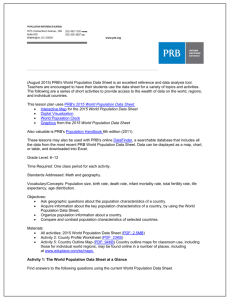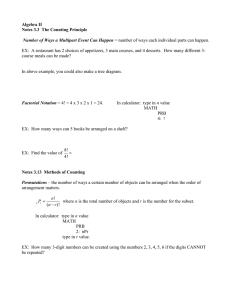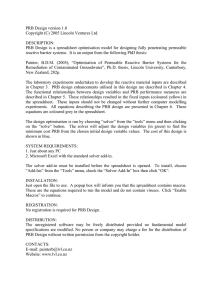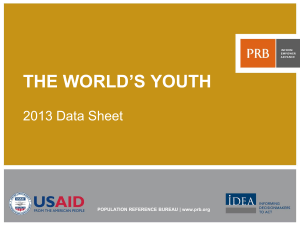The Retinoblastoma Protein Its Structure and Its Role in Cancer
advertisement
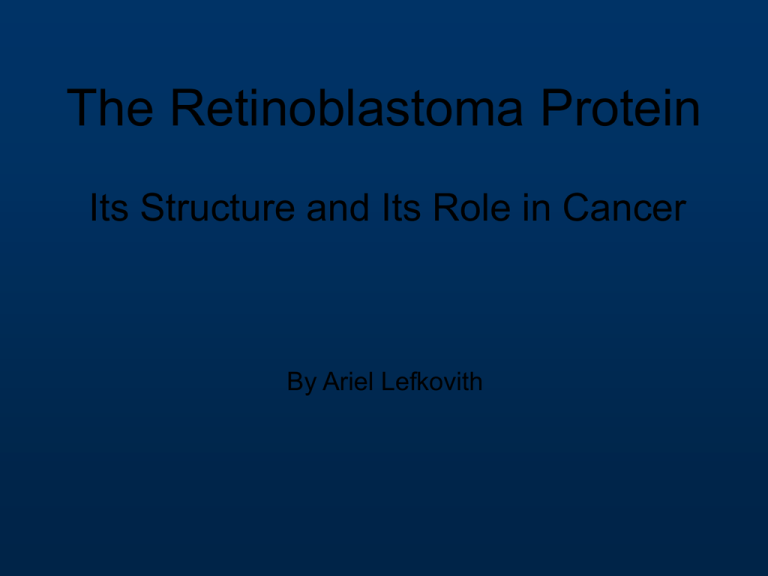
The Retinoblastoma Protein Its Structure and Its Role in Cancer By Ariel Lefkovith Cancers • • • • • • • • • • • Retinoblatoma Breast Cancer Cervical Cancer Colo-rectal cancer Endometrial cancer Head & neck cancer Liver cancer Lung cancer Malignant carcinoid Malignant glioma Urothelial cancer • • • • • • • • • • Malignant lymphoma Malignant melanoma Ovarian cancer Pancreatic cancer Prostate cancer Renal cancer Skin cancer Stomach cancer Testis cancer Thyroid cancer Background • • • • It is a protein product of the RB1 gene. A nuclear phosphoprotein. Gene cloned in 1986. Small cell lung carcinoma and Retinoblastoma are cancers in which the RB1 gene is mutated and RB1 loss of heterozygosity, forming Rb-/Rb-, is found in other cancers. • A tumor suppressor because of its control over the cell cycle. • Some viral oncoproteins can bind to pRb to deactivate it. pRB Role in the Cell Cycle • One of the factors needed to pass the restriction point from G1 phase to S phase. • pRB is bound to the E2F transcription factor. • pRB is phosphorylated by different cyclin-Cdk complexes at different stages of the cell cycle. • In G0 quiescent cells pRB is unphosphorylated and unbound. • In early G1 pRB is bound to E2F and becomes hypophosporylated by cyclin D-Cdk 4/6. • In late G1 pRB is bound to E2F and becomes hyperphosphorylated by cyclin E-Cdk 2. • The hyperphosphorylation of the pRB inactivates it, releasing E2F. The Cycle Structure • Three main Domains: N-terminal Domain, C-terminal Domain, and Pocket Domain. • The N-terminal domain has 379 residues. • The Pocket is made of 406 residues. • The C-terminal domain is a 143 residue domain. • Has 16 phosphorylation sites. The Pocket • Made up by A and B domains. • The two main structures are the A and B cyclin-box folds of five α helices each. • There are also 8 other α helices, a beta hairpin, and an extended tail. • The A-B Interface is held together by a hydrophobic core, created by 20 side chains and hydrogen bonds between the back bone and side chains. • E2F binds in the pocket. • Many of the mutations are found in the pocket. • The LxCxE site is on the B box. 5 10 2 3 7 13 6 4 17 11 18 12 8 9 14 16 1 15 The helices in Domain A are in red. The helices in Domain B are in green. The N-terminal Domain • Structure is hard to crystallize. • Has a globular structure formed by an A lobe and a B lobe. • Similar structure to the Pocket Domain. • The two lobes have separate hydrophobic cores. • It is hypothesized to be associated with familial retinoblastoma and could be involved with protein-protein interactions. Lobe A Lobe B The C-terminal Domain • Structure hard to crystalize. • This domain is necessary if pRB is stop cell progression by binding to E2F. • This domain binds to the E2F-DP heterodimer. • Phosphorylation also deactivates this domain from binding to the E2F-DP complex. • Part of this domain can bind to the LxCxE site on the pocket of the protein. C-terminal Domain Fragment bound to E2F-DP • The E2F-DP complex forms an intermolecular coiled coil, an intermolecular β sandwich, and 5 α helices. • The β sandwich has a hydrophobic core. • The fragment of RbC forms a strand-loop-helix structure and a tail. • The strand-loop of RbC binds to the β sandwich, and the tail loops around one end. • RbC binds to the E2F-DP complex through hydrogen bonds and van der Waals interactions. Red-RbC fragment Blue-DP Green-E2F pRB bound to E2F • Binds in the pRB pocket domain. • E2F binds residues on α4, α5, α6, α8, and α9 from A and α11 from B. • The ends of E2F make the most contact with pRB. • E2F binds to pRB by its main chain, which hydrogen bonds to pRB’s side chain. • Tyr(411), Leu(424), Phe(425), Glu(419), and Asp(423) are the five most important E2F residues. pRB •Domain A is red. •Domain B is neon green. E2F Residues •Tyr(411) is orange. •Asp(423) is blue. •Tyr(411)-E2F has a phenolic ring in a hydrophobic pocket of pRB, and its hydroxyl group makes a hydrogen bond to Glu(554)pRB. •Leu(424)-E2F and Phe(425)-E2F interact hydrophobicly with pRB at Lys(530)-pRB and Phe(482)-pRB •Glu(419)-E2F, which forms a hydrogen bond with a water molecule and Thr(645)-pRB. •Asp(423)-E2F, which forms a salt bridge with Arg(467)-pRB. •Asp(423)-E2F and Glu(419)-E2F point outward, unlike the other three residues that point inward. •Glu(419) is light blue. •Leu(424) is magenta. •Phe(425) is green LxCxE site • Is a shallow groove found on the B box of the pocket domain. • The groove is formed by α17, α14, α15 on the sides, the hydrophobic core of the B box, and α16 and α18 on the ends. • HPV E7, T antigen, and E1A oncoproteins all have the LxCxE motif and bind to the site to deactivate pRB. HPV E7 bound at LxCxE • Alternating Leu 22, Cys 24, Glu 26 (Green), and Leu 28 side chains point into the groove. • The sidechains that point in the box interact by van der Waals forces and hydrogen bonds. • Asp 21, Tyr 23, Tyr 25, Gln 27, and Asn 29 don’t bind because they point out of the box (Magenta). • Leu 22, Leu 28, and Cys 24 bind in hydrophobic pockets of the groove (Orange).
